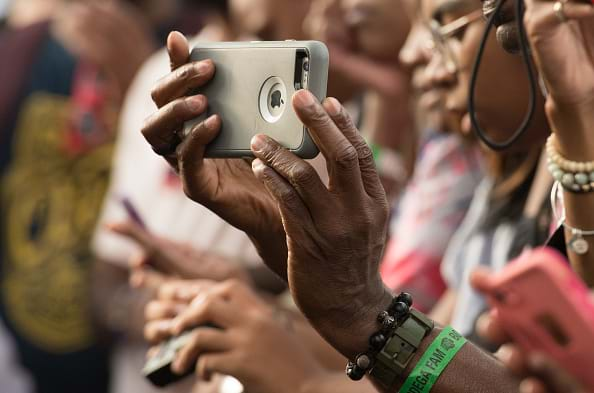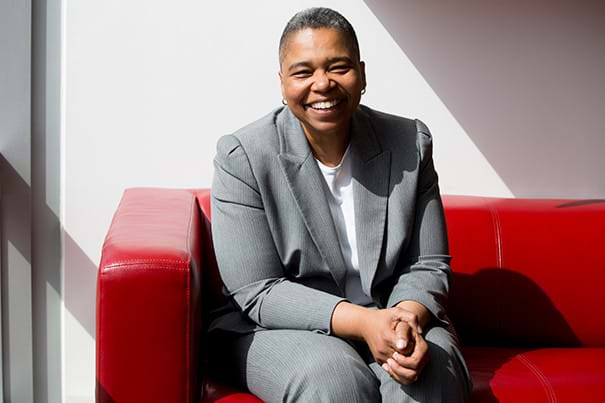
Latanya Sweeney is a computer scientist on the faculty of Harvard University. She studies the unforeseen consequences of technological innovation, and how to deal with them.
Ford Foundation: What issue in the technology sphere keeps you up at night?
Latanya Sweeney: The ways in which technology design has taken over society. Every democratic value is basically up for grabs by what technology design allows or doesn’t allow.
How so?
Think of the Sony camcorder. It was the first mass market device for recording sound and video at the same time, and it didn’t have a mute button. Doesn’t sound like a big deal, especially by today’s standard. When it came to market in 1984, American jurisprudence said it’s okay to photograph people in public, and you needed consent to record conversations. Here was this device that was going to record both video and sound. Legal issues came up right away. A woman in Pennsylvania strapped one of those camcorders to her child’s body and used it to record atrocities on the school bus. She ended up arrested for illegal wiretapping.
Nowadays, Pennsylvania has a law that requires video recording in all of its school buses. The lack of a mute button created changes. There were no laws or debates about it.
When technology is financially successful like it was in the case of camcorder, the design gets replicated. Today if you pull out a smartphone and you go to record a video, it doesn’t have a mute button either.

When did you first become fully aware of the impact technology has on policy?
I was a PhD student. One day I hear someone say, “Computers are evil.” I stopped, and find Beverly Woodward from Brandeis University. She talked about how technology was eroding our social contract around information. She said, ‘Even right now in Massachusetts, information from the health insurance for state employees, their families and retirees–that data has been given to researchers and sold to industry.’
The data she was describing didn’t have names, addresses, or Social Security numbers of people with particular diagnoses–sexually-transmitted diseases, drug use, things like that. It had month, day, year of birth, gender, ZIP code. I did a mathematical computation in my head. I started out trying to prove her wrong, and now I’m like, “Wait a second.”
William Weld was the governor. He had collapsed, and information about him was in that dataset. For $20 I got the Cambridge voter list, which included date of birth, gender, and ZIP code, along with names. That simple experiment ended up showing that data could be re-identified. The next day I was testifying before Congress. It was a profound point in my life–here was technology that I wanted the world to have, but nobody was looking out for these unforeseen consequences.
Why weren’t they?
It has to do with how innovations happen. Usually we have some goal, some new use of technology, like voice recognition. The team is already fixing a really hard problem: to make that vision come true. The last thing they want is to have their world complicated by having to also think about societal constraints. Technology gets built without that consideration.
Then it has to get commercialized. How is it going to make money? Is it going to be sustainable? The mute button is easy when you catch it at the design stage. It’s hard when they’ve already shipped millions of units worldwide and it’s in the marketplace.
How did you end up in academia?
All my life I loved mathematics. I wanted to build a thinking machine. As an undergraduate in the 1980s, I was usually the only black or only female in my classes. Personal computers were just coming out. Computer science was new. I don’t think I had a single professor who had a degree in computer science. They either had a degree in math or engineering. It didn’t take long before you knew about as much as your professors. Many of us left school and started companies.
I had a company for 10 years, but wasn’t happy. I would do something noteworthy, but there was nowhere to publish about it. There was no way to say, ‘You won’t believe what I just did!’ I wanted that. The only way to get that voice was to go back to school. I went back to Harvard, and then to MIT.
What advice do you give students interested in going into your field?
I got good at turning lemons into lemonade. I stopped caring about why someone wasn’t doing right by me, or giving me the same opportunities, or treating me unfairly.
New technology areas are prime territory for women and people of color. If you go into a discipline that’s well studied, the best you can do is put a little bitty brick into this huge wall. Public interest technology is a brand new area. It crosses disciplines. Young computer scientists, young technologists, young scholars from all backgrounds could find their place there. I teach a class called Technology Science to Save the World. The students literally solve real world problems. That shows the opportunity to have impact.
The last piece of advice is don’t try to get one person to be your advisor. Get six different people. Get this committee together. Each one may not be willing to take you under their wing, but they might give you some little nugget.
You left college to start a company and then left that to return to school. How was it different the second time around?
I was 10 years older. When I went back, I was incredibly confident. I had a sense of control over my destiny, over my environment. My sense of value and self-worth were no longer something the school gave me. I knew where my path was leading.
This interview has been condensed and edited.
Latanya is one of the Public Interest Tech voices we’ll be hearing from as part of this series over the next few weeks. Join us as we speak to thought leaders and discover their unique paths.
